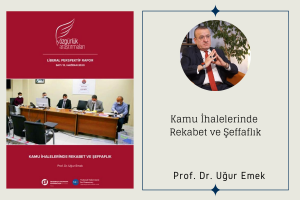Executive Summary
A good law contributes to the realization of its expected regulatory results. It demonstrates that
legislation is effective in achieving its predetermined goals. In order for the law to be effective,
appropriate and realistic policy measures, cost-effective enforcement mechanisms, and
ultimately the user’s willingness to implement it, as well as a judicial approach to ensure that the
law is interpreted according to its purpose are required.
Laws and regulations are expected to have the following fundamental features in practice:
● Serve clearly defined policy objectives and be effective in achieving them;
● Have a solid legal and realistic basis;
● Provide benefits that justify the costs, taking into account the distribution of their effects
in society and their economic, environmental and social impact;
● Minimize costs and market deviations;
● Promote innovation through market incentives and targeted approaches;
● Be clear, simple and practical to users;
● Be consistent with other regulations and policies;
● Be as compatible as possible with principles that facilitate competition, trade and
investment at the local and international level.
Regulatory impact assessment/analysis (RIA) examines the effects and consequences of a range
of alternative options, including non-regulatory ones, to policy makers as to whether and how
they should regulate in order to achieve public policy objectives; thus, helping in determining the
most appropriate, efficient and effective policy in the public interest before making the final
decision.
The “Better Regulation Guideline” and “Better Regulation Toolbox” prepared by the European
Commission for member countries, together with the OECD’s work on the principles of good
practice on Regulatory Impact Assessment prepared within the framework of the
“Recommendation on Regulatory Policy and Governance ” of 2012, provide a guide to policy
makers. They provide comprehensive information and guidance on how to conduct an impact
assessment.
Legislative quality, which is an important standard in evaluating the effectiveness of the
legislative, is a multifaceted concept. The function and purpose of the legislative is shaped by the
different legal traditions, forms of government, drafting procedures and practices of different
actors according to the needs and priorities in certain historical, political and social contexts.
The precision of a law in achieving its intended outputs, and its clarity and simplicity to be
understood by the average citizen with its effectiveness, are two elements of legislative quality.
The first element has to do with the intrinsic quality of the law, or its accuracy in reflecting
legislative policy. The second element requires the use of language that will enable the text of the
law to be understood by those who will apply the law and those who will be affected by it.
In the regulatory oversight function,
● Quality control (examination of the flow of new regulations);
● Identifying policy areas where regulation could be made more effective (examination of
the existing regulatory stock);
● Systematic improvement of regulatory policy (examination of the system);
● Coordination (ensuring consistency of approach in management);
● Guidance, advice and support (development of management capacity) are the main tools.
Ex ante and ex post reviews ensure democratic governance, early warning of legislators of
unintended consequences, the effectiveness and efficiency of law, and the quality and
effectiveness of legislation (regulatory management).
RIA covers the analysis, evaluation and testing of the indicators, outputs and their impact
regarding the action proposal developed by the government to solve a defined social or economic
problem. Therefore, by preparing evidence-based policymaking, possible failures of regulation
are avoided. Briefly, the problem that drives the government and the goal of solving the problem
are analyzed.
Post-legislative review (PLR), is the institutionalization and systematization of analysis and
evaluation focused on rationalizing the legislative process and improving the quality of laws; as
well as determining whether the legislator’s objectives are fulfilled appropriately and effectively,
and whether some undesirable consequences of the law have arisen in practice during
Parliament’s monitoring of the implementation of the law after it was passed. As part of
parliamentary oversight and monitoring, the PLR performs two different functions. Firstly, it is a
monitoring function in which the implementation of legislation and in particular the necessary
secondary legislation are evaluated by the parliament. Secondly, it is the evaluation of the
legislation reflected in the outputs and effects of the policies to ensure that their normative
objectives are fulfilled.
PLR can be organized according to different criteria depending on the subject and the provisions
of the law. However, PLR can be tied to a number of key standards and criteria. Questions to
consider are:
● Did the law meet policy objectives?
● What unintended consequences (good or bad) has the law led to?
● What was the effect of the legislation on administrative processes?
● Has there been a formal problem in the application?
● Have legal objections or comments been made that reveal the incompleteness or
complexity of the law?
● Is the law clear, simple and well prepared?
● Does the law complement or contradict other laws and policies?
● Did the law affect different groups in society differently or unfairly?
● Do the provisions of the law need to be explained, promoted or advertised more broadly?
● Is there sufficient information and awareness in the public about the law?
● Was the funding allocated for the implementation sufficient?
● Did the law provide any meaningful monetary value?
● What good practices and other lessons can be drawn from the implementation of the law?
● Have the political and legal context changed in such a way that the law is no longer
needed?
In addition to the problems caused by the presidential government system in the areas of
separation of powers as well as checks and balances, there are ongoing institutional problems
regarding the legislative and supervisory functions of the TGNA. It is emphasized that ex ante
evaluations ineffective and ex post evaluations are not carried out, and that stakeholder
participation in the legislative process is not sustainable and effective. When establishing
mechanisms on how to develop a draft law, the TGNA should first consider the
recommendations of organizations such as the OECD and the World Bank on good regulatory
practice.
The two most important tools that ensure the legitimacy of evidence-based regulations are
general justification, article justifications and the RIA. It is obligatory to write the general and
article justifications of the laws according to the provisions of the Bylaws. Although the RIA tool
has been regulated in 2005 and most recently at the beginning of 2022 and mandated, it has not
been effectively implemented.
The only and most important method of enforcing the laws is the ex post or PLR. Evidence-
based assessment of whether laws benefit citizens as originally intended by legislators; in short,
evaluation of the effectiveness, efficiency and effectiveness of the law is only possible with RIA
and PLR.
Inadequacies in the legislative and legislative process in Turkey negatively affect the quality of
legislation and the effectiveness and efficiency of the public service are decreasing. In addition
to the negative effects of the change in the government system, the ongoing systemic problems in
the legislative quality could not be solved despite the good intentions.
RIA and PLR are of vital importance in the legislative process and in the implementation of
laws, which complement and influence each other. The institutional strengthening of the TGNA
and the realization of good political governance are only possible if such tools become
operational.
* Prof. Dr. Ömer Faruk Gençkaya





